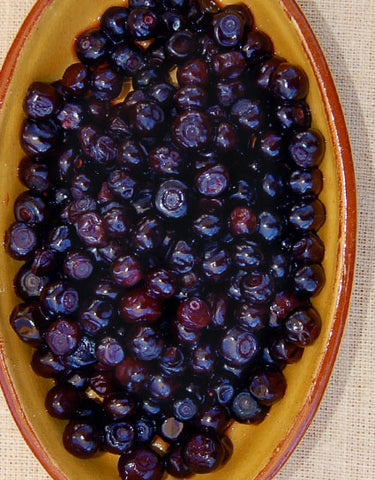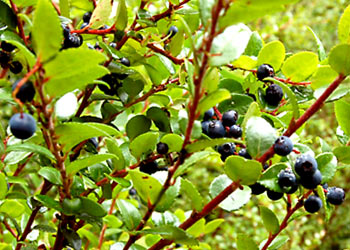Wild Huckleberries
 Vaccininum membranceum/ Globare (complex)' V. ovatum; Gaylussacia species
Vaccininum membranceum/ Globare (complex)' V. ovatum; Gaylussacia species
The delightful word huckleberry, means one kind of berry in Massachusetts, another kind in Missouri, another in Montana, and yet another at America’s edge along the Mendocino coast. This same charming name is used for at least six species of purple berries. Like the orthodox devotion to one’s regional BBQ, every region knows that their type of huckleberry is superior. I personally adore our Pacific coastal evergreen huckleberries, V. ovatum, while my friends in Montana think I’m crazy to like those tiny tart berry ball compared to their big fat sweet berries.
I’ve been surprised and delighted that every French Chef I know adores huckleberries. Though often so resistant to unfamiliar ingredients, the French readily fall madly in love with these berries. One of the few joys in writing orders down at 3AM is hearing a Frenchman’s thick accent saying “huck eel bear ei”.
All these lovely huckleberry cousins have a distinctive crown-shaped mark on the bottom of the berry. This is the same mark you’ve seen hundreds of times on the base of blueberries. Unlike the related blueberries, huckleberries usually have no frosted “bloom” on the berry skin. Huckleberries also are generally more intense in flavor with a brighter acid/sugar balance and a juicier interior.
Huckleberries can be sorted into three rough groups: the western mountain species; Huck Finn’s huckleberry which grows to the east of the great plains; and the evergreen huckleberry of the Pacific coast. The Vaccinium gang(genus) contains both the coastal evergreen huckleberry and the plumper mountain species. The Vaccinium genus also contain huckleberry’s cousins the blueberry and the cranberry.

“Mountain” Huckleberry
Vaccinum membranaceum/globare complex
The mountain huckleberry is large in size (like a fat pea), juicier, and tends to a red-violet color. Vast portions of the West are sprinkled with these huckleberry bushes. Its hungry admirers include Grizzly bears, black bears, birds and hundreds of generations of native humans. This deciduous bush with its lance-shaped leaves, is found from three to seven thousand foot elevations. The productive bushes range from ten inches to about four feet tall, a very picker friendly size.
Coastal Evergreen Huckleberry
Vaccinium ovatum
The smaller Vaccinium ovatum, is a dainty blue-violet berry. It has thicker skin and an excellent sugar acid balance. The difficulty in stem removal with these is balanced by their great flavor and their ability to remain as unbroken berries. You’ve probably seen its beautiful foliage in flower arrangements. Its thick glossy alternative leafed branches are harvested for the floral industry. The coastal huckleberry bushes can be as large as 10 feet tall. Great thickets of these huckleberries are common place for many miles inland along the Pacific coast. It’s difficult but rewarding scrambling to hunt for the hedgehog, yellow feet and black trumpet mushrooms that are found so frequently under these bushes.
Eastern Huckleberry
Gaylussacia species
In the East, Gaylussacia species, al la Huckleberry Finn and Walden, are yet another great berry wearing the huckleberry moniker. They often intermingle with low bush blueberries. People in the East pick them almost interchangeably. Unlike Western huckleberries, they have ten small seeds.
|
Cleaning A bucket of berries harvested by combing and “beating the bushes” contains many leaves and even smaller unripe green berries. Some people submerge the berries in a bucket then skimming off the floating debris. This is the least desirable method. It water logs the berries and dilutes their flavor. Creating a ramp to roll the berries down is certainly the best way. There are numerous variations on the ramp technique. One nice way is to get a long strip of screen or hardware cloth with holes smaller than the size of your berries. Bend the screen into a long gutter-shape. Raise one end at least three feet higher than the other end which should end in a bucket. Pour the unclean berries down the ramp. Leaves will stick in the screen and the smaller green berries should fall through the screen as they roll downhill. Another easy ramp is just a pair of boards, in a “V” shape, or an old gutter. Line either with an old blanket. The leaves and twigs stick to the blanket while the berries roll away down into a bucket. If you add little horizontal baffles to the gutter or chute, the big clean berries bounce over these obstacles leaving even more particles and debris behind. It’s reminiscent of gold miner’s chutes. This method works best with the larger mountain huckleberries whose stems break off fairly easily. The coastal evergreens are not as easy to clean. Because of the tenacious stems- hand-picking makes good sense. I often freeze the berries then clean them while frozen. You roll the berries around with your hands on a sheet pan, the stems fall off easily. Then just shake them in a strainer and the stems will fall through. Seasonality They ripen in late July through mid-September in most areas except the coastal West where the evergreen huckleberry can continue to be picked as late as mid-November. Cooking Though it’s hard to get past eating them all fresh from your purple palms, huckleberries cook up wonderfully well. You can simply cook them briefly with sugar as a little compote topping over ice cream or bake them in a pastry. Huckleberries can have a few stems remaining since they’ll be tenderized by the cooking process.
Harvesting After the berries ripen between late July and October the picking begins. The harvesting of huckleberries boils down to three main methods: hand picking; combs or rakes; and beating the bushes. Hand-picking is very slow, although the fussiness of this picking method results in the extremely clean berries that makes unnecessary the grooming routine required by comb picking, or beating. Berry rakes or combs, are the human attempt to replace our hands with bear claws. The “claws” are metal rods attached to a scoop or metal can which catches the berries as the whole unite combs the berry-laden branches. The berries are stripped off the branches. As you comb up through a berry covered branch- berries accompanied by some leaves, fall into the scoop. Berry rakes can be purchased online. Some tribal peoples used salmon backbones as berry combs. “Beating the bushes” You start this method by spreading a tarp or sheet under a berry covered bush. Once placed, you pat-pat the branches with whisk brooms or paddles. Old-fashioned whish brooms or even ping-pong paddles work nicely. The berries fall on the tarp. In an odd variation, a superfine lined big fish net can be held with one hand under the branches to catch the berries as the other hand beats the branches with a whisk broom. Preservation These berries freeze marvelously. Before freezing, put them in a bag with a little air space then put in your freezer. In about 3-4 hours, remove from the freezer and squeeze the bag a little to break up the berries as they freeze. You don’t want them to freeze as a solid mass. It’s nice to be able to remove a cup of berries at a time as needed for the odd ice cream sundae or whatever you please. Dried huckleberries are lovely in homemade granola. They become huckleberry “raisins”. You'll find scrumptios Wine Forest Wild Huckleberry Jam in our online retail pantry store. Storage Unlike most berries, huckleberries in a plastic bag will keep in your refrigerator extremely well. Ten days in your refrigerator is a reasonable expectation. |

